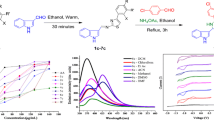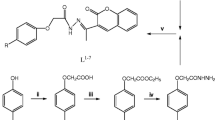Abstract
A novel Schiff base ligand (L = 7-methoxychromone-3-carbaldehyde benzoyl hydrazone) and its La(III) and Eu(III) complexes have been successfully prepared. The crystal structure of [LaL2(NO3)3]·H2O was characterized by X-ray crystallography. It crystallizes in monoclinic, space group C2/c with crystallographic data: a = 27.7173(17) Å, b = 10.0002(6) Å, c = 14.7884(9) Å, β = 102.6870(10)° and Z = 4. In the structure, the La(III) ion satisfies 12 coordination and three nitrate coordinate as bidentate ligand. The biological experiments show that the ligand and its two complexes can strongly bind to DNA through intercalation mode, and the three compounds also exhibit good antioxidant activities against OH• and O2 −•. Moreover, it is found that the Eu(III) complex exhibits characteristic fluorescence of europium ion in different organic solvent.









Similar content being viewed by others
References
Wong E, Giandomenico CM (1999) Current status of platinum-based antitumor drugs. Chem Rev 99:2451–2466, doi:10.1021/cr980420v
Lebwohl D, Canetta R (1998) Clinical development of platinum complexes in cancer therapy: an historical perspective and an update. Eur J Cancer 34:1522–1534, doi:10.1016/S0959-8049(98)00224-X
Clarke MJ, Zhu F, Frasca DR (1999) Non-platinum chemotherapeutic metallopharmaceuticals. Chem Rev 99:2511–2533, doi:10.1021/cr9804238
Ronconi L, Sadler PJ (2007) Using coordination chemistry to design new medicines. Coord Chem Rev 251:1633–1648, doi:10.1016/j.ccr.2006.11.017
Juskowiak B, Grzybowska I, Galezowska E, Takenaka S (2004) Enhanced fluorescence of the Eu3+-naphthalenediimide derivative-phenanthroline ternary complex and the determination of DNA. Anal Chim Acta 512:133–139, doi:10.1016/j.aca.2004.02.037
Li SH, Yuan WT, Zhu CQ, Xu JG (2004) Species-differentiable sensing of phosphate-containing anions in neutral aqueous solution based on coordinatively unsaturated lanthanide complex probes. Anal Biochem 331:235–242, doi:10.1016/j.ab.2004.05.024
Hasegawa Y, Wada Y, Yanagida S (2004) Strategies for the design of luminescent lanthanide(III) complexes and their photonic applications. J Photochem Photobiol Photochem Rev 5:183–202, doi:10.1016/j.jphotochemrev.2004.10.003
Ci YX, Li YZ, Chang WB (1991) Fluorescence reaction of terbium (III) with nucleic acids in the presence of phenanthroline. Anal Chim Acta 248:589–594, doi:10.1016/S0003-2670(00)84680-2
Horne DZ, Dervan PB (1990) Recognition of mixed-sequence duplex DNA by alternate-strand triple-helix formation. J Am Chem Soc 112:2435–2437, doi:10.1021/ja00162a063
Moser HE, Dervan PB (1987) Sequence-specific cleavage of double helical DNA by triple helix formation. Science 238:645–650, doi:10.1126/science.3118463
Gottes field JM, Nealy L, Trauger JW, Baird EE, Dervan PB (1997) Regulation of gene expression with pyrrole–imidazole polyamides. Nature 387:202–205
Herman DM, Turner JM, Baird EE, Derban PB (1999) Cycle polyamide motif for recognition of the minor groove of DNA. J Am Chem Soc 121:1121–1129, doi:10.1021/ja983206x
Gale PA (2003) Anion and ion-pair receptor chemistry: highlights from 2000 and 2001. Chem Rev 240:191–221
Keefe MH, Benkstein KD, Hupp JT (2000) Luminescent sensor molecules based on coordinated metals: a review of recent developments. Coord Chem Rev 205:201–228, doi:10.1016/S0010-8545(00)00240-X
Wang BD, Yang ZY, Li TR (2006) Synthesis, characterization, and DNA-binding properties of the Ln(III) complexes with 6-hydroxy chromone-3-carbaldehyde-(2′-hydroxy) benzoyl hydrazone. Bioorg Med Chem 14:6012–6021, doi:10.1016/j.bmc.2006.05.015
Fujimori T, Yamada S, Yasui H, Sakurai H, In Y, Ishida T (2005) Orally active antioxidative copper(II) aspirinate: synthesis, structure characterization, superoxide scavenging activity, and in vitro and in vivo antioxidative evaluations. J Biol Inorg Chem 10:831–841, doi:10.1007/s00775-005-0031-3
Cohen G, Eisenberg H (1969) Viscosity and sedimentation study of sonicated DNA–proflavin complexes. Biopolymers 8:45–55, doi:10.1002/bip.1969.360080105
Sheldrick GM (1997) SHELXL-97, Program for Refinement of Crystal Structures. University of Göttingen, Göttingen
Hogberg T, Vora M, Drake S, Mitscher LA, Chu DTW (1984) Structure–activity relationships among DNA-gyrase inhibitors. Synthesis and antimicrobial evaluation of chromones and coumarins related to oxolinic acid. Acta Chem Scand B 38:359–366, doi:10.3891/acta.chem.scand.38b-0359
Nakamoto K (1986) Infrared and Raman spectra of inorganic and coordination compounds, 4th edn. Wiley, New York
Harman ME, Hart FA, Hursthouse MB, Moss GP, Raithby PR (1976) 12-Co-ordinated crown ether complex of lanthanum: X-ray crystal structure. JCS Chem Comm 396–397
Liu HQ, Cheung TC, Che CM (1996) Cyclometallated platinum(II) complexes as luminescent switches for calf-thymus DNA. Chem Commun (Camb.) 1039–1040, doi:10.1039/cc9960001039
Tang Y, Tang KZ, Zhang J, Su CY, Liu WS, Tan MY (2005) Crystal structures and luminescent properties of the lanthanide picrate complexes with an amide-type tripodal ligand. Inorg Chem Commun 8:1018–1021, doi:10.1016/j.inoche.2005.07.024
Barton JK, Dannenberg JJ, Raphael AL (1984) Tris(phenanthroline)ruthenium(II): stereoselectivity in binding to DNA. J Am Chem Soc 106:2172–2176, doi:10.1021/ja00319a043
Yadav RC, Kumar GS, Bhadra K, Giri P, Sinha R, Pal S et al (2005) Berberine, a strong polyriboadenylic acid binding plant alkaloid: spectroscopic, viscometric, and thermodynamic study. Bioorg Med Chem 13:165–174, doi:10.1016/j.bmc.2004.09.045
Xu H, Kang CZ, Li JL, Li H, Gao Y, Ji LN (2004) Effects of the substitution positions of Br group in intercalative ligand on the DNA-binding behaviors of Ru(II) polypyridyl complexes. J Inorg Biochem 98:87–97, doi:10.1016/j.jinorgbio.2003.09.002
Satyanarayana S, Dabroniak JC, Chaires JB (1992) Neither DELTA nor LAMB Tris (phenanthroline) ruthenium (II) binds to DNA by classical intercalation. Biochemistry 31:9319–9324, doi:10.1021/bi00154a001
Pyle AM, Rehmann JP, Meshoyrer R, Kumar CV, Turro NJ, Barton JK (1989) Mixed-ligand complexes of ruthenium(II): factors governing binding to DNA. J Am Chem Soc 111:3051–3058, doi:10.1021/ja00190a046
Deng H, Cai JW, Xu H, Zhang H, Ji LN (2003) Ruthenium(II) complexes containing asymmetric ligands: synthesis, characterization, crystal structure and DNA-binding. Dalton Trans 325–330, doi:10.1039/b208400g
Friedman AE, Chambron JC, Sauvage JP, Turro NJ, Barton JK (1990) A molecular light switch for DNA: Ru(bpy)2(dppz)2+. J Am Chem Soc 112:4960–4962, doi:10.1021/ja00168a052
Boger DL, Fink BE, Brunette SR, Tse WC, Hedrick MP (2001) A simple, high-resolution method for establishing DNA binding affinity and sequence selectivity. J Am Chem Soc 123:5878–5891, doi:10.1021/ja010041a
Efink MR, Ghiron CA (1981) Fluorescence quenching studies with proteins. Anal Biochem 114:199–227, doi:10.1016/0003-2697(81)90474-7
Palchaudhuri R, Hergenrother PJ (2007) DNA as a target for anticancer compounds: methods to determine the mode of binding and the mechanism of action. Curr Opin Biotechnol 18:1–7, doi:10.1016/j.copbio.2007.09.006
Fiorentino A, D’Abrosca B, Pacifico S, Iacovino R, Mastellone C, Di Blasio B et al (2006) Distachyasin: a new antioxidant metabolite from the leaves of Carex distachya. Bioorg Med Chem Lett 16:6096–6101, doi:10.1016/j.bmcl.2006.08.106
Acknowledgements
This work is supported by the National Natural Science Foundation of China (20475023) and Gansu NSF(0710RJZA012).
Author information
Authors and Affiliations
Corresponding author
Rights and permissions
About this article
Cite this article
Qin, Dd., Qi, Gf., Yang, Zy. et al. Fluorescence and Biological Evaluation of the La(III) and Eu(III) Complexes with 7-methoxychromone-3-carbaldehyde Benzoyl Hydrazone Schiff Base. J Fluoresc 19, 409–418 (2009). https://doi.org/10.1007/s10895-008-0427-x
Received:
Accepted:
Published:
Issue Date:
DOI: https://doi.org/10.1007/s10895-008-0427-x




